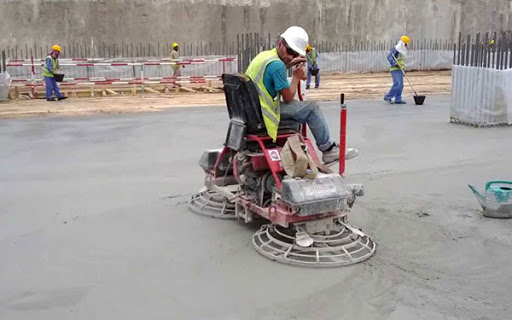Tremix: High-Performance Concrete Pavement or Flooring Work.
Tremix: High-Performance Concrete Pavement or Flooring Work.
Tremix is also called vacuum dewater flooring or simply (VDF) through a vacuum. Dewatering process surplus water from the concrete is removed immediately after placing and vibration of concrete.
The process of suction of water reduces the water-cement ratio to the optimum level, by reducing the water-cement ratio, especially at the top, the compressive strength and density of concrete increases. This provides better wearing and bearing properties of the concrete surface.
Generally, the mix of concrete is M 20 or M 25. The Plain Cement Concrete (PCC) base below the Reinforced Cement Concrete (RCC) surface should be kept up to 100 millimeters thick. The RCC thickness varies between 100 to 200 millimeters, depending upon loading required.
Uses of Tremix
Tremix system is commonly used in making industrial floor’s concrete roads, runways, railways, platforms warehouse, container yards, canal lining, pathways, bridges, RCC roads, etcetera.
Design Consideration
The following should be considered while constructing a tremix floor
- Wear resistance prevent aberration due to vehicle movement.
- Joint strengths to prevent chipping of concrete at weak joints.
- Impact resistance prevent damages from the impact of falling objects
- Slope requirements for proper drainage of spills.
- Concentrated loads as in case of machinery loading
- Surface flatness for installation of racks
Tremix Special tools
Along with regular concrete mason tools, special tools required for tremix flooring work are;
- Vacuum dewatering pump
- Floater machine.
- Try mix mitt and
- Double beam screed vibrator.
Tremix Process
Tremix process involves following eight steps.
- Fixing of guide rails
- Placing concrete
- Concrete spreading
- Surface vibration/leveling
- Vacuum dewatering surface/ suction of water
- Power floating
- Power troweling of the top surface
- Curing to gain strength.
The Benefits of Tremix Flooring.
- Due to the removal of excess water, the floor’s compressive strength increases by up to 60%, resulting in higher structural strength and durability.
- An increase in tensile strength and abrasion resistance of the floor increases by up to 70%.
- Additionally, cement consumption is reduced as no additional cement is required separately for finishing the top surface.
- As the concrete surface becomes denser, permeability is reduced as a result of which liquids falling on the floor have a less detrimental effect on the concrete
- Impact strength is increased,
- Shrinkage of concrete is reduced, and the floor warps less.
Challenges During Premix.
- Settlement of concrete might occur due to the removal of water during hot temperature
- Concrete sets quickly, causing shrinkage cracks.
- There is also the possibility of the removal of fine particles such as cement.
- Additionally, there is the possibility of removal of water which might be required for hydration.
Placing Sequence of Tremix
- In most cases, the efficient way to place concrete in large areas is in long alternating strips called panels.
- Reinforcement needs to be tied for each panel.
- A checkerboard sequence of placement is commonly used, which permitted concrete shrinkage of casted panels before adjoining pavements are casted
- Roughly 80 to 120 square meters of the area can be covered in a day by a concrete mason by using a walk-behind floater and a trowel.
- Assuming a width of the panel to be 4 m, a 30 m long panels are usually casted
- However, experience has shown that the earlier placements’ shrinkage occurs too slowly for the checkered board method to be effective.
- New recommendations are that the checkerboard sequence of placement not be used any longer.
- Instead, a large block of concrete placements up two to base-wide should be followed. This can be achieved by using ride-on trowels.
- A trowel in which an operator sits on a seat installed upon the machinery. A sheet of plastic is used as vapour barriers.
- It helps protect from the transmission of moisture upward through the concrete slab from sources in the base and subbase layers.
- The plastic sheet thickness depends upon the amount of protection required on the moisture sensitivity of the local ground conditions.
- It can be placed directly beneath the RCC surface or on a granular fill layer below the PCC.
Precaution against evaporation
Rapid evaporation and moisture loss can result in plastic shrinkage cracking in this lab surface.
This undesirable appearance can be prevented by using windbreaks or sunshades or treating the concrete with a thin water film just after using power trowels.
Surface tolerances.
In the past, floor profile quality had been specified by limiting the size of the gap Measured under 3 m long aluminium piece placed anywhere on the floor.
Recently the floor quality is measured in two different numbers.
The flatness number
This controls the floor surface by limiting the magnitude of successive 1 ft slope changes Measured on a predetermined line.
Construction methods and finishing techniques usually control flatness.
The level news number
This defines the floor surface’s relative conformity to a horizontal plane, as measured over a 10 ft distance. Levelness is controlled by precise forming or by the use of a laser screed.
Range of surface tolerances.
The range of floor tolerance is being achieved by historical device’ a bull float- average flatness received will have a variance of 13 millimeters.
By using a double screed surface vibrator, the flatness achieved is eight millimeters variants.
The best quality is achieved using a laser screed surface flatness of up to 3.2 millimeters.


